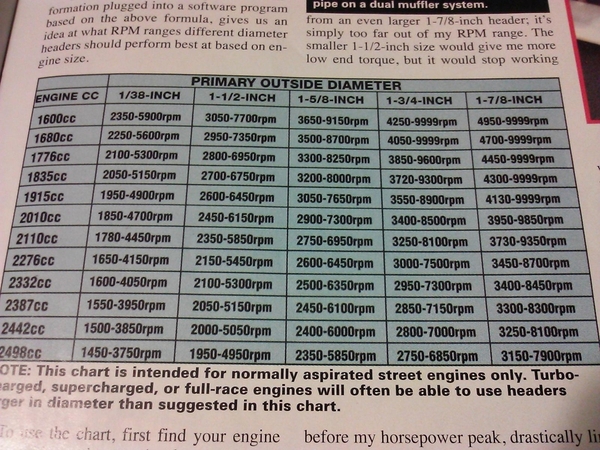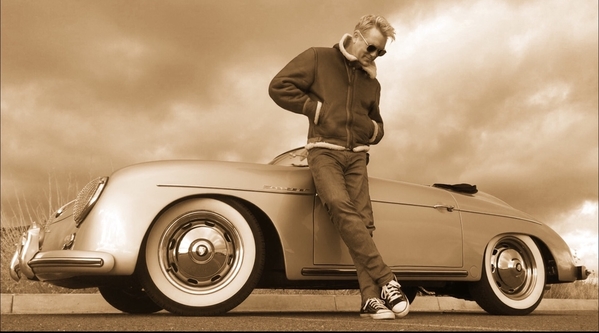I'm not an expert by any means. If experience is the best teacher, and experience is gained by making mistakes, I'd be on my way to a doctorate.
However, this just isn't the case.
I sometimes delude myself by thinking I'm on my way to being as smart as the guys who've done their actual doctorate work on this stuff because I bump my way around the garage. They've worked out the physics of this stuff, and any conclusions I eventually arrive at through tons of mistakes generally end up lining up with the actual math. I've found (way too late) that it's probably more productive to read what they have to say before I spend a bunch of money and time on (yet another) failed experiment.
Al's chart is pretty accurate, but it presupposes an extractor-type exhaust. Before your eyes glaze over, hear me out. An equal-length 4 into 1 header (like Gordon's merge) is almost magical. It works by actually drawing a vacuum on the exhaust port of each cylinder, because the other three cylinders are creating a venturi at the collector (the "1" part of 4 into 1). The length and diameter of the tubes coming from each individual cylinder and the size of the collector "tune" the exhaust to create a more powerful vacuum in certain RPM ranges.
The vacuum on the exhaust port really helps with getting the spent gases out of the cylinder, and actually helps suck the intake gases into the cylinder. The effect of the vacuum on the exhaust port is actually many times stronger than the vacuum of the piston falling in the cylinder. That's the magical part.
A 2110 with a 1-1/2" equal-length 4 into 1 header is a really sweet little engine. A 2110 with a 1-5/8" equal-length 4 into 1 header is sweet as well, but it moves the "sweet-spot" up in the RPM register. It'll be soggier down low, but scream harder on the top. On the street, I like the feel of the 1-1/2” equal-length 4 into 1 header better.
The thing is- the Vintage Speed exhaust you're looking at (as well as the Tri-Mill, the Monza, and others of this ilk) are not extractor-type headers, so they don't work the same way. There is still something of the vacuum effect, but it is not really tuned in any meaningful way. As an aside- the A1 sidewinder we all swoon over IS a 4-1 design, but the tubes are nowhere near equal-length, so the effect is nowhere near as good as it is with a merge exhaust. Look at any dyno-day monster pull, and it'll be through a true equal-length 4-1 merge header.
Also, it's a misconception that ANY engine "likes back-pressure". What they like is extraction, and an engine with an exhaust will always run better than one without-- not because there is back-pressure, but because the tubes of the exhaust keep a steam of hot gases moving in the right direction and create a vacuum on the exhaust port. This is extraction, and all exhausts do this to one degree or another, but some much more effectively. Back-pressure without any extraction would effectively stuff the exhaust gases back into the cylinder and kill it.
The way the Vintage Speed set-up extracts exhaust gasses (reasonably) well is by means of that big-'ol muffler looking thing (the can, if you will). On the Vintage Speed set-up, that can is actually an expansion chamber, which creates a vacuum by means of being a (comparative) low-pressure zone. It works because there isn't much in there, and it's big. A Tri-Mil doesn't work as well because the can is much smaller. A Monza is probably the worst of all.
What does all this mean? It means that Gordon's equal-length 1-1/2" merge 4 into1 header is probably perfect for the average street 2110. If that exhaust was an A1 sidewinder unequal-length 4 into 1, I'd still probably pick a 1-1/2" header. But if I wanted an expansion-chamber exhaust like the Vintage Speed, I'd probably step up to a 1-5/8" set-up.
Nothing is perfect. The Sidewinder came about because the 4 into 1 merge header points the collector straight back, and ends up with a goofy-looking U-tube to get the exhaust back under the car. By rolling the collector sideways, the entire thing could tuck up and (mostly) out of sight. The Vintage Speed exhaust gives up the powerful extraction of a 4 into 1 header for a much more compact and pretty package.
What compromises you want to make should determine what exhaust to run.
![]()

















